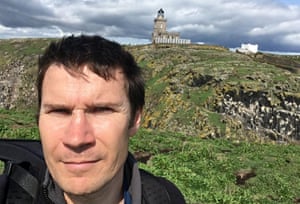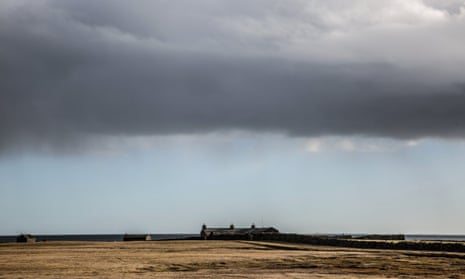One November, close to burnout, I left my job as a hospital doctor in Edinburgh for the Hebridean island of Barra. From the lee of an abandoned cottage, where I sheltered from the driving rain, the island at first seemed desolate, empty, solitary.
A headland stood over a broad bay of white sand chopped by relentless sallies of rolling grey waves. Down on the beach, the sands were sheened in a thin film of seawater which seemed neither to flow nor drain – a mirror over the earth, doubling the drama of the skies. I surprised two sea otters at play and picked up a bobbing audience of inquisitive seals that floated just offshore, following me as I made my way along the strandline. There were just a few hours of light to each day of the week I spent walking circuits of those beaches, but the purity and simplicity of the landscape – just hills, grass, sea, wind – lent a clarity to my mind that had been lacking for what felt like months.

Blue skies, golden beaches, perhaps a hammock strung between palm trees … this is what people tend to think of at the mention of the word “island”. But for me, the austere landscapes of more northerly isles – particularly in winter – offer just as many gifts, a solace of a different kind.
Over my hotel breakfast each morning I’d talk with Christine, the establishment’s only waitress. She was Barra born and raised but moved away in her 20s to study social sciences in Glasgow. Her mother’s illness called her back, and she’d been home now for a year. With the easy candour between two strangers unlikely to see one another again she served up her dilemma along with my tea and toast: to stay on the island where she felt she belonged, or return to the city with all its possibilities?

I knew well her predicament, though from the other side of the mirror: just as she felt trapped by the island, I’d run to it with a sense of release. It was a pattern that has repeated itself throughout my life: across 30 years of travel, on seven continents, isolation and connection have been the two energising poles. First, immersion in medical practice for its intensity, its social engagement, its ringside seat to all the bustle and brilliance of humanity. And then island postings and polar travel – for the distance and perspective they grant, for the chance to feel part of a world somewhat emptied of the human, for their silence and space for contemplation. It’s a pattern that’s taken me from the Faroe Islands to the Falklands, from Canada to Cape Horn, from the Andaman Islands to Arran – and then always back to the city and profession I love.
But it has been among Scotland’s northern and western isles that I’ve most often found this kind of rebalancing. I remember a New Year’s Day on the island of Mull, climbing Ben More with friends, feeling that any cares I carried had been left behind at sea level. The mountain’s summit was snagged on a patchy canopy of clouds, but in clear moments when I looked west to the isles of Ulva, Eorsa and Iona, and east into a labyrinth of silent glens, I hardly wanted to come down.

One year, in the run-up to the winter solstice, I travelled to North Ronaldsay, the northernmost of the Orkneys, to stay at the Bird Observatory guesthouse. The pervasive darkness there much of each day meant that the sparse hours of light, filtering through mist and clouds from a sun low on the southern horizon, felt more precious; the laughter, camaraderie and conversation around the dinner table each evening were sweeter too.
Another year, in Orkney again for the solstice, I crept into the neolithic monument of Maeshowe. It was already centuries old when the pyramids were new, and like the pyramids, the craft with which it was built still astonishes. Those Orcadians of the past were inseparable from their land and skies, and Maeshowe is the ultimate expression of a rootedness I admire but have never experienced. I watched as winter solstice sunlight rolled like honey up the stone passageway, illuminating the back wall of the chamber in a promise of spring’s return.
Back on Barra, drenched from another day’s walking, I hitched a lift with George, who had retired to the island after 40 years in Glasgow. He smiled and nodded when I told him I was from Edinburgh, but there was a pity in his voice, too. “Oh, Edinburgh’s a busy place,” he said, then paused and gestured out over the north Atlantic, next stop America. “Aye, far too busy.”

On my last day in Barra I picked my way northwards across bay after bay of rock and sand, watching the patterns and harmonics of the waves as they broke around the headlands. Around one of them I was stopped by the deep stillness and beauty: thick mist put the world into soft focus, and the sound of the waves was dampened to a plangent sigh. For a moment, everything did seem simple – so different from the hectic complexity of my hospital work. The following day I boarded the ferry with a strange mixture of regret and gladness about the life and work that awaited me. My winter journey had effected some kind of rebalancing – burnout had been averted, without a hammock or a palm tree in sight. I knew now that George was right: the city was too busy for comfort. Yet Christine also was right – like her I knew that after a few months on the island, I’d begin to yearn for it too.
Gavin Francis is author of Island Dreams – Mapping an Obsession (Canongate, £20 hardback) which is shortlisted for Waterstones Book of the Year. Available at the Guardian Bookshop for £17.40





